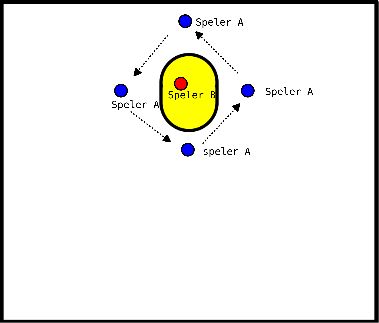Korfball drills
- Make pairs at the hive.
- Place two hats approximately 2.5 meters apart and 2.5 meters from the basket, as shown on the diagram.
- Player 1 starts in the middle, Player 2 starts as passer/rebounder under the basket.
- Player 1 makes a fierce running line to the one hat, receives the ball on the outside hand and passes back.
- Player 1 makes a fierce run to the other hat and scores a short chance.
- You do this for 1 minute, after this you switch.
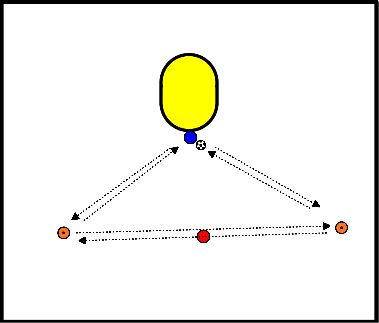
- The baskets are in the middle of the box/field lengthwise
- Player with ball under the post.
- Player 1 takes the through ball and passes to player 3. Who takes a through ball and goes to the spot of 1.
- 3 minutes of running from line to line and scoring through balls on the front underhand and on the back overhand. At 50% speed.
After each minute, the declarer switches without stopping the exercise. - 3 minutes at 75%.
- 1.5 minutes at 100% but slow down
- 3 minutes at 75%
- 3 minutes at 50%
- 3 minutes of running from line to line and scoring through balls on the front underhand and on the back overhand. At 50% speed.
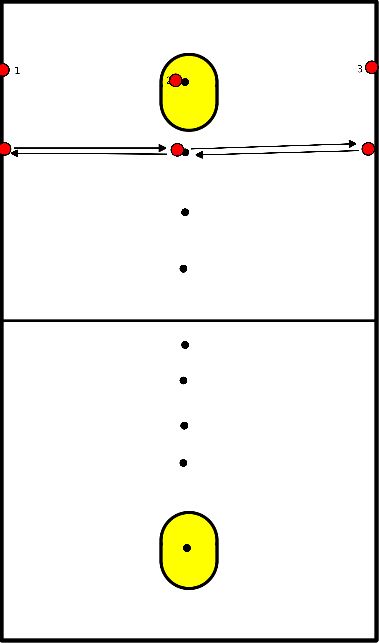
Training objective:
Picking up the shot directly in a duel between them.
Shot duel
Per 2-team a ball and a post.
Picking up the shot directly in a duel between them.
Shot duel
Per 2-team a ball and a post.
- Making 2 out of 5 distance shots from 6 meters.
- Then you get one chance from 4 meters.
- You must score the one from 4 meters to earn a point.
- Your opponent can undo this point by also scoring the 4-meter chance.
- Score 3 out of 5 short chances from 4 meters.
- Then score 2 penalty throws, on 2, to earn a point.
- Your opponent can undo this by also scoring both penalty throws.
- Score 2 out of 5 shots behind the basket at 5 meters.
- Then score 3 through balls, from 3 chances, to earn a point.
- Your opponent can undo this by also scoring 3 through balls.
- Score 1 out of 5 distance shots at 8 meters.
- Then score 3 out of 4 chances under the basket.
- Your opponent can undo this by scoring 3 out of 3 chances under the basket.
- Divide the group into groups of 3.
- Give each group 5 jars in 5 different colors.
- 1 player goes to work -red, 1 player indicates -blue, 1 player coaches -white.
- Player red starts running action from pot to pot in slalom and takes a run-in.
- Player white coaches player red and indicates which jar player red should go back and start again, again in slalom.
- If player red scores from a color pot, player white takes the pot away.
- Exercise continues until every color pot is scored.
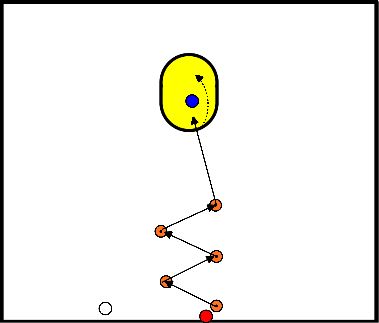
- Player 1 stands by the pawn
- Player 2 comes to offer next to player 1 and doubles once
- Player 2 then runs deep
- Player 1 goes after his own ball and makes a handover
- Player 2 takes a through ball
- Exchange after X chances
- Scoring a total of X goals
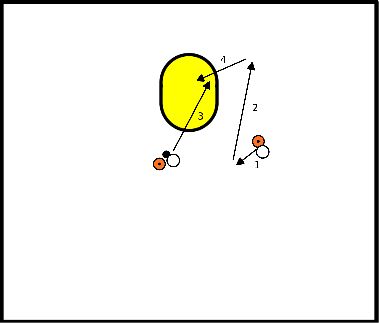
- Everyone stands at his/her pawn 5 meters from the basket.
- One player has the ball and shoots.
- The others engage in the rebound duel-the shooter, too, if necessary.
- Whoever has the ball then gets to shoot.
- Who has X goals first?
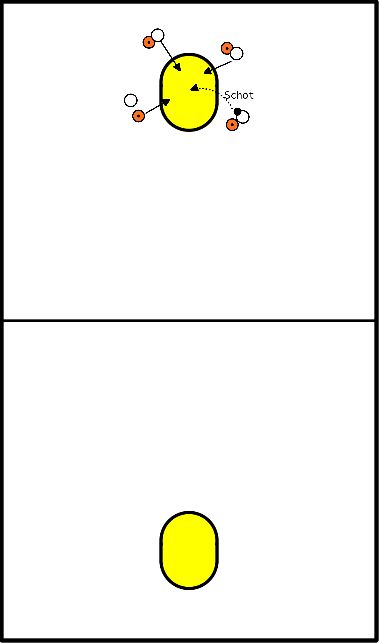
Duration: 10 minutes.
"From one sideline to the other sideline. We stay on the same line together and keep pace with (player's name)."
Exercises:
Exercises:
- 2x runs.
- 2x hopping (swinging arms).
- 2x knee lifts (up to the half).
- 2x heels buttocks (up to half).
- 1x sideways left.
- 1x sideways right.
- 1x cross step (switching sides at half).
- 3x run (speed up a bit each time).
Only the square and not the diamond is used in this form of training. The primary training objectives here are:
- Keeping space in the box, through running lines in a square
- Timely replenishment of vacant position, timing running moments.
- Passing ball at pace to next player.
Note: the square must be smaller because the diamond is not used initially. Player must be at a distance they can throw.
For the exercise, there is an inside and outside square marked by pawns. So players are not allowed to go outside that path and therefore not make the square smaller than that:
- Player 1 plays to 2 -> runs after own ball at reasonable pace;
- Player 2 plays directly to 3 -> runs at reasonable pace after own ball;
- etc.
- The ball pace goes up slowly.
- When the children have this under control, the ball goes the other way.
The ball should be passed quickly and passed faster and faster.
Eventually, players should always be able to get to the empty spot just in time, because the pace of the ball is almost faster than that of the players.
Eventually, players should always be able to get to the empty spot just in time, because the pace of the ball is almost faster than that of the players.
Playing tight balls is a requirement here.
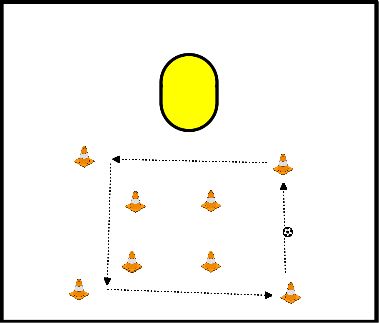
By 3 at a basket.
Step 1:
Step 1:
- Player Red defends Player Blue.
- Player Blue has the ball and then throws it to Player White and runs deep and shoots.
Step 2:
- Follow Step 1 and after Player Blue runs deep, Player White rushes in for a giveaway.
- Player Blue goes for a pass through Blue.
- Player Red continues to defend, but allows the through ball.
Take the goal attempts as calmly as possible
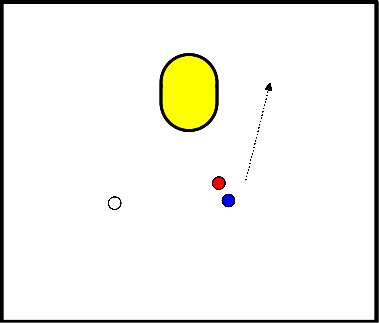
- The player goes down the speed ladder from the left side to the center. There the ball is ready on the ground,
- This ball is played inside and then the person who ran the ladder runs around the ladder and cuts inside with speed.
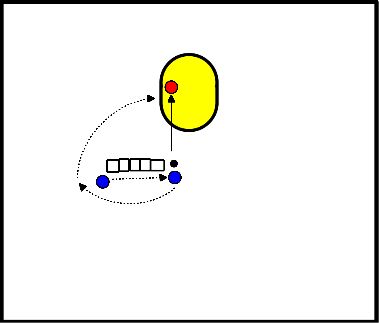
- The speed ladder is approximately 7 meters diagonally in front of the basket, on the left side.
- The player runs the speed ladder sideways facing the basket, gets the ball at the end, rebounds it and deflects for a shot.
Of course, this exercise can also be performed at the back or another side.
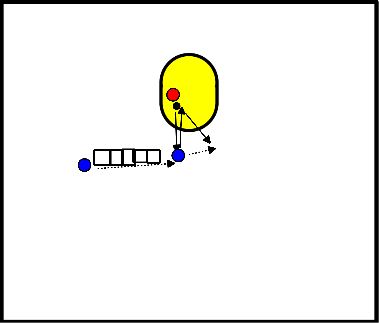
- Player A starts in front of the post with a shot until he/she scores.
- After a goal to next point.
- If missing; run back and forth to previous spot and shoot where you missed.
- Finish the round.
- This can also be done without running up and down.
